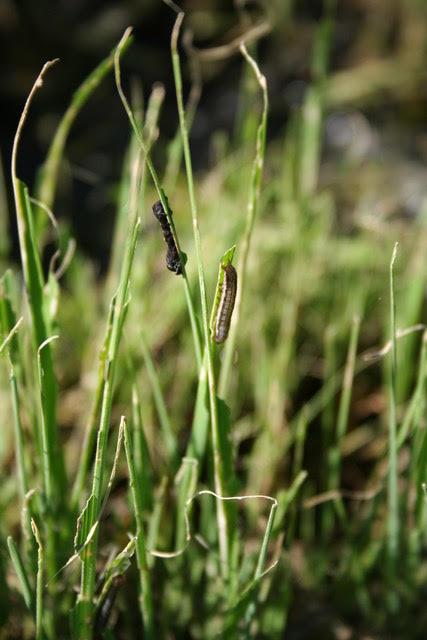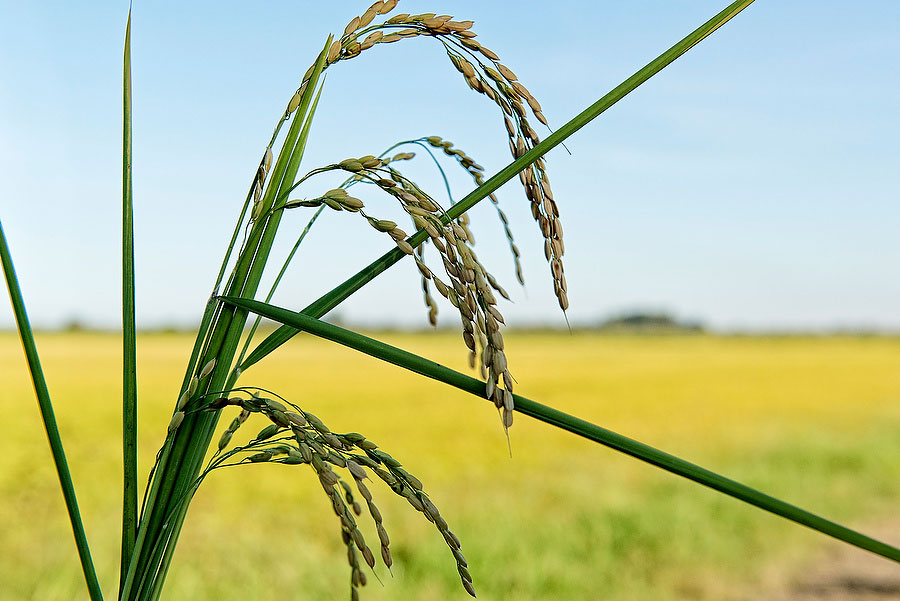Access to methoxyfenozide expands rice growers’ toolbox for future armyworm infestations

California produces over 500,000 acres of rice—the majority grown in the Sacramento Valley. Photo courtesy of the California Rice Commission.
California rice is a critical crop to protect. There are over 500,000 acres of rice grown in California with the majority of the crop produced in the Sacramento Valley. Rice is one of the state’s biggest crops, contributing more than $5 billion to its economy with nearly 5 billion pounds of rice produced annually.
While rice is not a specialty crop, IR-4 offered expertise to help growers secure a tool for armyworm management following a 2015 outbreak. This story of collaboration illustrates how The IR-4 Project can aid major crops like rice in gaining specialty uses when existing tools fall short.
A perfect storm for armyworms
While California-grown rice doesn’t typically face major insect pests, a variety of circumstances led to an outbreak of unprecedented armyworm pressure in 2015.
“Armyworms are only an occasional pest on rice,” said Roberta Firoved, a pesticide regulatory consultant and former industry affairs manager at the California Rice Commission. “Maybe once every five years armyworms show up in the rice fields. In many cases, birds or an insecticide spot treatment kept the armyworms under control.”
In 2015, however, the armyworm population exploded in the rice fields. The state was experiencing above-average temperatures and drought conditions. California growers encountered a significant armyworm infestation during the summer in crops throughout the state.
“Drought conditions that occur in California are typically cyclic,” Firoved said. “The warmer, dryer winters are ideal for armyworms to overwinter. Usually, if the winters are cold, wet, and foggy, there is a larger die-off of the armyworms.”
In the Sacramento Valley during 2015, there were a lot of fallow fields with the only green plants in production being rice.
“The worms were discovered in the fields at the mature larval stage,” Firoved said. “This is the stage that has developed resistance to pyrethroid insecticides. The worms were also very large, about the size of a little finger, and nothing was slowing them down.”
Another critical factor was the stage of plant growth at the time of infestation. Rice is planted in April through the end of May; herbicide applications typically start around this time and are completed by late June. Armyworms, which had previously appeared later in the summer, started to show up in the rice fields in late June of 2015. Warmer temperatures seemed to spur the growth of the worms.

A major infestation by western yellowstriped armyworm (Spodoptera praefica) on California rice in 2015 caused growers to seek emergency insecticide options. Photo by Jack Kelly Clark, Univ. of Calif. IPM.
Devastating plant damage
The two armyworm species that infested California rice plants in 2015 were the true armyworm (Pseudaletia unipuncta Haworth) and western yellowstriped armyworm (Spodoptera praefica).
“In other crops, the armyworms made an initial flush and then died out,” Firoved said. “During the heavy infestation in 2015, a second flush of armyworms occurred in August during the panicle fill, when the rice kernels are forming and the panicles were falling off the plants. Forty-day-old rice is approximately 12 inches above the water line. The armyworms chewed off the stalks and the plants looked like they had been mowed down leaving only stubble.”
Identifying an effective control
Since there were no effective insecticides labeled for armyworms on rice, growers were desperate to find some type of control to save their crops and prepare for future unpredictable seasons. Aware of the losses the growers were facing, Rick Geddes (now retired) at Dow AgroSciences, now Corteva Agriscience, contacted Firoved at the California Rice Commission about the insecticide methoxyfenozide, which is an effective control for Lepidoptera pests in other crops.
“I immediately called the state entomologist about methoxyfenozide and was told that, if the rice growers can get this insecticide, they should do it,” Firoved said.
Geddes set up a meeting between Dow AgroSciences management and the California Rice Commission about supporting an emergency exemption for methoxyfenozide. After the meeting, Dow officials agreed to support the rice industry’s request for a Section 18 emergency exemption, which was issued in August of 2015.
In 2016, the California Rice Commission submitted a Project Clearance Request (PCR) to the IR-4 Project to expand the methoxyfenozide label for rice. Another Section 18 emergency exemption application was submitted. A Section 18 exemption has to be applied for every year or every time one is needed. A Section 18 application was submitted on an annual basis for eight years until the methoxyfenozide registration was completed in 2022 for the 2023 use season.
“It is relatively novel for a Section 18 to be submitted and approved for that long,” Firoved said. “The California Rice Commission did a lot of work to demonstrate to EPA [the importance of the] pursuit of registration for methoxyfenozide.”

A second flush of armyworms occurred in August of 2015 when rice kernels were forming; growers had no options to control the infestation. Photo courtesy of Luis Espino, Univ. of Calif. Cooperative Extension.
Cooperative effort to control armyworms
Brian Bret, U.S. regulatory leader at Corteva Agriscience, was the IR-4 Project liaison for Dow AgroSciences at the time the California Rice Commission made the request for the Section 18 emergency exemption.
“We were approached by the rice commission about supporting a label expansion for methoxyfenozide (Intrepid 2F) to help rice growers protect their crops from outbreaks of the western yellowstriped armyworm,” Bret said. “As the company liaison between IR-4, the growers, and Dow, I forwarded the request to our biologists, our business team, and the U.S. regulatory manager for methoxyfenozide to determine if all were supportive of IR-4 proceeding with residue trials, proposing a tolerance, and submitting this information to U.S. EPA.”
In emergency situations, existing data from other crops helps enormously to build a case for a Section 18 exemption. In this case, Western yellowstriped armyworm was a common pest on other California crops, and the efficacy of methoxyfenozide was well-documented against armyworm. This offered hope to the rice industry that Intrepid might be a workable solution with a regulatory path forward.
Bret explained that the demonstrable need from rice growers and the good relations the California Rice Commission had with California Department of Pesticide Regulation was instrumental in having the Section 18 approved.
“It is very difficult to obtain a Section 18 in California,” he said. “It’s a tribute to the efforts of the rice commission and rice industry to get this done. There were also University of California researchers who were doing trials with rice to find the most effective product to control the armyworm. State extension specialists were able to share efficacy data for rice showing how well methoxyfenozide controlled the armyworms.”
Meeting the needs of the growers
The label expansion of methoxyfenozide is a good example of a minor use on a major crop—a smaller part of IR-4’s work but an important aspect of the organizational mission.
“Rice is not usually considered a minor crop,” Bret said. “Armyworms would infest some acreage in different locations. During the crisis, these infestations were enough to cause economic effects for the growers. This helped IR-4 and the rice commission to justify the argument to EPA that in the case of rice, this was a minor use on a major crop and therefore eligible for IR-4 support.”
Firoved emphasized that IR-4’s work is critical to supporting minor crops with pesticide registration challenges.
“Most specialty crops don’t have the backing of organizations representing them,” she said. “IR-4 develops trusted data. It meets requirements for pesticide registration for both the U.S. EPA and California Department of Pesticide Regulation. It is important for the agriculture industry to continue working with IR-4 in support of product registration to ensure a safe food supply.”
For more:
Roberta Firoved: robertafiroved@gmail.com
Brian Bret: brian.bret@corteva.com
David Kuack is a freelance technical writer in Fort Worth, Texas; dkuack@gmail.com

A healthy rice crop; photo courtesy of the California Rice Commission.
